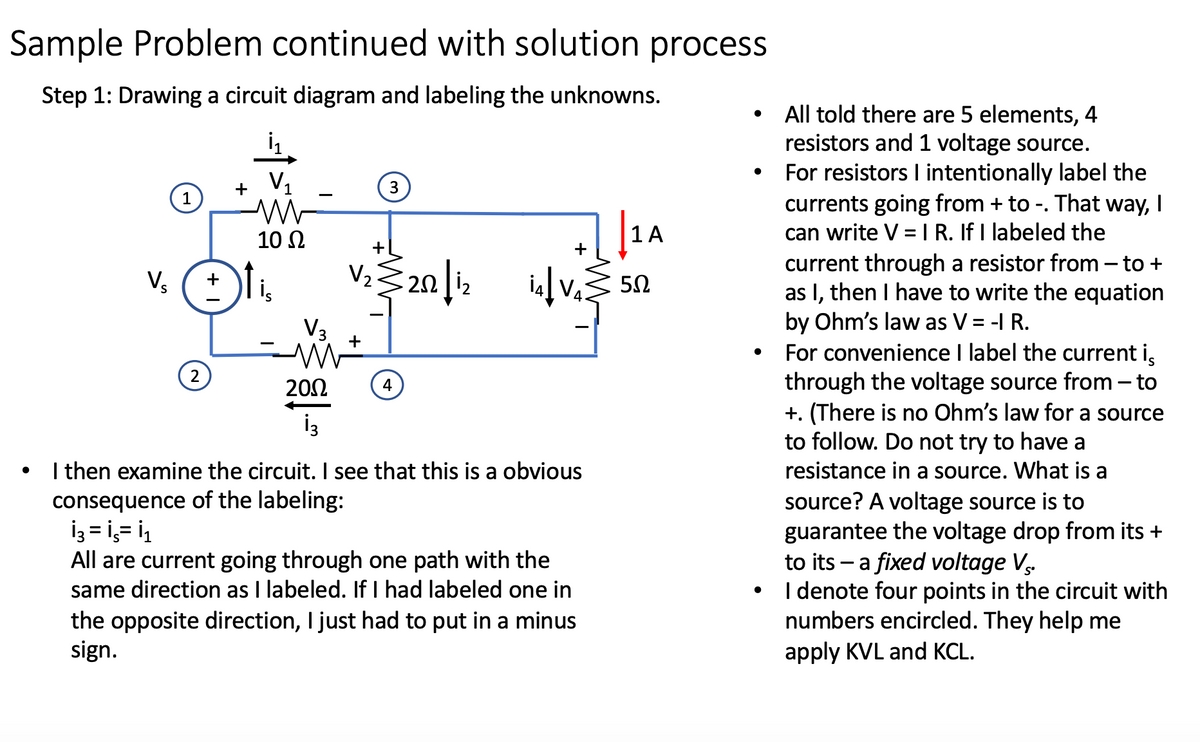Sample Problem continued with solution process Step 1: Drawing a circuit diagram and labeling the unknowns. All told there are 5 elements, 4 resistors and 1 voltage source. For resistors I intentionally label the currents going from + to -. That way, I can write V =| R. If I labeled the current through a resistor from – to + as I, then I have to write the equation by Ohm's law as V = -I R. For convenience I label the current i, through the voltage source from – to +. (There is no Ohm's law for a source to follow. Do not try to have a |1A 10 N + + V, 2 20Ω 4 I then examine the circuit. I see that this is a obvious consequence of the labeling: İ3 = i,= i, All are current going through one path with the same direction as I labeled. If I had labeled one in the opposite direction, I just had to put in a minus sign. resistance in a source. What is a source? A voltage source is to guarantee the voltage drop from its + to its – a fixed voltage V. I denote four points in the circuit with numbers encircled. They help me apply KVL and KCL.
Sample Problem continued with solution process Step 1: Drawing a circuit diagram and labeling the unknowns. All told there are 5 elements, 4 resistors and 1 voltage source. For resistors I intentionally label the currents going from + to -. That way, I can write V =| R. If I labeled the current through a resistor from – to + as I, then I have to write the equation by Ohm's law as V = -I R. For convenience I label the current i, through the voltage source from – to +. (There is no Ohm's law for a source to follow. Do not try to have a |1A 10 N + + V, 2 20Ω 4 I then examine the circuit. I see that this is a obvious consequence of the labeling: İ3 = i,= i, All are current going through one path with the same direction as I labeled. If I had labeled one in the opposite direction, I just had to put in a minus sign. resistance in a source. What is a source? A voltage source is to guarantee the voltage drop from its + to its – a fixed voltage V. I denote four points in the circuit with numbers encircled. They help me apply KVL and KCL.
Introductory Circuit Analysis (13th Edition)
13th Edition
ISBN:9780133923605
Author:Robert L. Boylestad
Publisher:Robert L. Boylestad
Chapter1: Introduction
Section: Chapter Questions
Problem 1P: Visit your local library (at school or home) and describe the extent to which it provides literature...
Related questions
Question

Transcribed Image Text:Sample Problem continued with solution process
Step 1: Drawing a circuit diagram and labeling the unknowns.
All told there are 5 elements, 4
resistors and 1 voltage source.
For resistors I intentionally label the
currents going from + to -. That way, I
can write V = I R. If I labeled the
current through a resistor from – to +
as I, then I have to write the equation
by Ohm's law as V = -I R.
For convenience I label the current i,
through the voltage source from – to
+. (There is no Ohm's law for a source
to follow. Do not try to have a
resistance in a source. What is a
V,
3
+
(1
|1A
10 Ω
+
V,
iş
V2
20 i2
V3
+
2
20Ω
4
İz
I then examine the circuit. I see that this is a obvious
consequence of the labeling:
iz = i,= i,
All are current going through one path with the
same direction as I labeled. If I had labeled one in
the opposite direction, I just had to put in a minus
sign.
source? A voltage source is to
guarantee the voltage drop from its +
to its – a fixed voltage V,.
I denote four points in the circuit with
numbers encircled. They help me
apply KVL and KCL.
S°
Expert Solution
This question has been solved!
Explore an expertly crafted, step-by-step solution for a thorough understanding of key concepts.
Step by step
Solved in 2 steps with 2 images

Knowledge Booster
Learn more about
Need a deep-dive on the concept behind this application? Look no further. Learn more about this topic, electrical-engineering and related others by exploring similar questions and additional content below.Recommended textbooks for you

Introductory Circuit Analysis (13th Edition)
Electrical Engineering
ISBN:
9780133923605
Author:
Robert L. Boylestad
Publisher:
PEARSON

Delmar's Standard Textbook Of Electricity
Electrical Engineering
ISBN:
9781337900348
Author:
Stephen L. Herman
Publisher:
Cengage Learning

Programmable Logic Controllers
Electrical Engineering
ISBN:
9780073373843
Author:
Frank D. Petruzella
Publisher:
McGraw-Hill Education

Introductory Circuit Analysis (13th Edition)
Electrical Engineering
ISBN:
9780133923605
Author:
Robert L. Boylestad
Publisher:
PEARSON

Delmar's Standard Textbook Of Electricity
Electrical Engineering
ISBN:
9781337900348
Author:
Stephen L. Herman
Publisher:
Cengage Learning

Programmable Logic Controllers
Electrical Engineering
ISBN:
9780073373843
Author:
Frank D. Petruzella
Publisher:
McGraw-Hill Education

Fundamentals of Electric Circuits
Electrical Engineering
ISBN:
9780078028229
Author:
Charles K Alexander, Matthew Sadiku
Publisher:
McGraw-Hill Education

Electric Circuits. (11th Edition)
Electrical Engineering
ISBN:
9780134746968
Author:
James W. Nilsson, Susan Riedel
Publisher:
PEARSON

Engineering Electromagnetics
Electrical Engineering
ISBN:
9780078028151
Author:
Hayt, William H. (william Hart), Jr, BUCK, John A.
Publisher:
Mcgraw-hill Education,